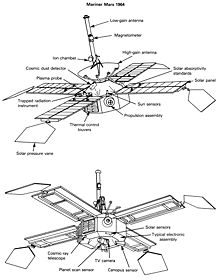Mariner 3
 Mariner 3 is identical in design with Mariner 4 | |
| Mission type | Mars flyby |
|---|---|
| Operator | NASA / JPL |
| COSPAR ID | 1964-073A |
| SATCAT no. | 923 |
| Mission duration | Launch failure |
| Spacecraft properties | |
| Manufacturer | Jet Propulsion Laboratory |
| Launch mass | 260.8 kilograms (575 lb) |
| Power | 310 watts (at Mars encounter) |
| Start of mission | |
| Launch date | November 5, 1964, 19:22:05 UTC |
| Rocket | Atlas LV-3 Agena-D |
| Launch site | Cape Canaveral LC-13 |
| Contractor | Convair |
| Orbital parameters | |
| Reference system | Heliocentric |
Mariner 3 (together with Mariner 4 known as Mariner-Mars 1964) was one of two identical deep-space probes designed and built by the Jet Propulsion Laboratory (JPL) for NASA's Mariner-Mars 1964 project that were intended to conduct close-up (flyby) scientific observations of the planet Mars and transmit information on interplanetary space and the space surrounding Mars, televised images of the Martian surface and radio occultation data of spacecraft signals as affected by the Martian atmosphere back to Earth.[1][2]
Although the launch was initially successful, there was a separation issue and Mariner 3 stopped responding when its batteries ran out of power. It was the third of ten spacecraft within the Mariner program.
Background
[edit]
Mariner 2 had been a modified Ranger lunar probe, however Mariner 3 used a new, larger bus with four solar panels, a TV camera, and additional instrumentation. Because of the greater mass, the new Agena D stage would be used instead of the Agena B. Mariner 3 also utilized a new, larger fiberglass payload fairing. Of the two Atlas-Agena pads at Cape Canaveral, LC-13 became available first following the launch of an Air Force Vela satellite in July 1964. Atlas vehicle 289D was erected on the pad on August 17, with the backup Mariner probe and booster (Atlas 288D) erected on LC-12 on September 28.
Launch failure
[edit]Mariner 3 was launched at 2:22 PM EST on November 5, 1964, from Cape Kennedy Air Force Station Launch Complex 13. After an uneventful boost phase, the Agena completed its burn to place the probe on a trajectory towards Mars. One hour after launch, the first telemetry transmissions from Mariner 3 were received, indicating that the scientific instruments were functioning correctly but there was no indication of any solar panel operation. Unsure of the exact problem, ground controllers issued a command to turn off the rate gyros to conserve power while they worked to figure out what had happened. Telemetry data suggested a separation failure of either the Agena or the payload fairing, but a below-normal velocity appeared to indicate that the fairing had not separated properly. A command was sent to manually jettison the payload shroud, but nothing happened. The ground controllers next considered firing Mariner 3's midcourse correction engine to blow off the shroud, but they ran out of time. Eight hours after launch, the batteries in the probe died and the mission was officially terminated. Even if the shroud could be removed, the mission would have failed, since the low velocity meant that Mariner 3 would miss Mars by several million miles.[3][4]
Three weeks later, on November 28, 1964, Mariner 4 was launched successfully on a 7½-month voyage to Mars.
Instruments
[edit]The instruments on Mariner 3 included:[5]
- Television camera
- Magnetometer
- Plasma probe
- Cosmic ray telescope
- Trapped radiation detector
- Cosmic ray ionization chamber
- Cosmic dust detector
See also
[edit]References
[edit]- ^ "Mariner Mars 1964 Mechanical Configuration" (PDF). NASA. Archived from the original (PDF) on May 22, 2010. Retrieved December 29, 2011.
- ^ D. W. Douglas (August 17, 1964). Spaceflight Operations Plan Mariner Mars '64 (PDF). NASA. 19660014211. Retrieved December 29, 2011.
- ^ "Launch Complex 13". Archived from the original on October 10, 2018. Retrieved August 27, 2012.
- ^ Rod Pyle (2012). Destination Mars: New Explorations of the Red Planet. Prometheus Books. p. 348. ISBN 978-1-61614-589-7.
It eventually joined its sibling, Mariner 3, dead ... in a large orbit around the sun.
- ^ JPL Technical Memorandum No. 33-229, To Mars: The Odyssey of Mariner IV (PDF) (Report). NASA / JPL. January 1, 1965. pp. 21–23. Archived (PDF) from the original on April 13, 2022. Retrieved November 3, 2012.
External links
[edit]- Mariner 3 Mission Profile by NASA's Solar System Exploration
- Space Flight Operations Plan Mariner Mars '64 (PDF)
Lua error in Module:Navbox at line 535: attempt to get length of local 'arg' (a number value). Lua error in Module:Navbox at line 535: attempt to get length of local 'arg' (a number value). Lua error in Module:Navbox at line 535: attempt to get length of local 'arg' (a number value).
